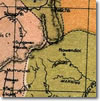
Pastoral Station entry
| Home | Browse | Search | Previous | Next |

|
Unlocking Regional Memory
Pastoral Station entry
|
|
Wongwibinda Station (1842 - ) |
||
|
||
| Location: Wongwibinda, New South Wales, Australia | ||
Originally known as Kangaroo Hills, the run now called Wongwibinda is situated 60 kilometres north-east of Armidale on the New England tablelands in northern New South Wales. It was first occupied by William Dangar, of Tilbuster near Armidale, and covered about 40,000 acres. Because of its remote location, however, Kangaroo Hills proved unpopular and was sold on a number of occasions over the next fifty years. By the 1880s, it was in the hands of James Withycombe, who, like so many before him, was determined to dispose of the property because of its perceived unprofitability. Around this time, Albert and May Wright, of Nulalbin Station, in central Queensland, began searching for a pastoral station in the New England region. Overcome with the many problems associated with managing Nulalbin and convinced that the hot weather had contributed to the death of their young son, Bertie, they looked to settling in a cooler climate and in 1885 purchased Kangaroo Hills from Withycombe. According to Weeta Wright, Albert and May’s eldest daughter, Withycombe was ‘thankful to get rid’ of the place. Its general neglect over the years meant that when the Wrights arrived Kangaroo Hills was ‘almost in its wild natural state’. Nevertheless, Albert saw great promise in the property, which they renamed Wongwibinda, an Aboriginal word meaning ‘stay a long time’ or ‘permanent camp’. He immediately set to work clearing, draining and fencing the land. He built a new homestead and by the following year was running more than 2,000 head of cattle on Wongwibinda. Sheep were introduced shortly thereafter, and although the property would always run cattle, in time it became predominantly a wool station. Tragically, however, Albert Wright died from pneumonia in 1890, and despite advice to the contrary, May decided to run the station alone. In this respect she was eminently successful. By 1912, Wongwibinda carried 8,000 sheep and 1,250 head of cattle. When she died in 1929, May Wright left a financially secure property for her son, Cecil, who over the next twenty years made further improvements to the property; a woolshed was built and the introduction new technology such as tractors and new techniques such as the application of superphosphate added considerably to the efficiency and viability of Wongwbinda Station. The property remains in the hands of Albert Wright’s descendants. Full Note:
Related People: References: |
|
|
| ||
|
Published by The Australian Science and Technology Heritage Centre, 5 April 2004 Prepared by: Acknowledgements Updated: 23 February 2010 http://www.nswera.net.au/biogs/UNE0529b.htm |